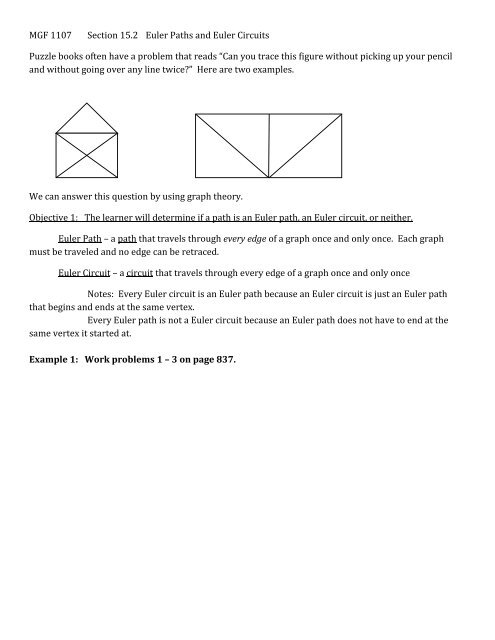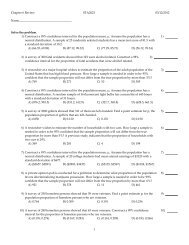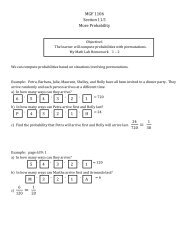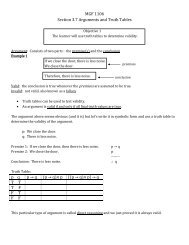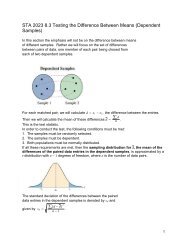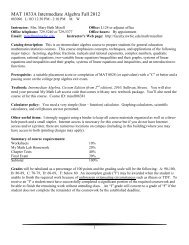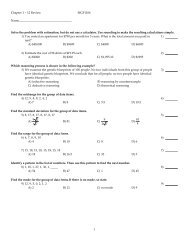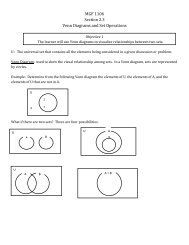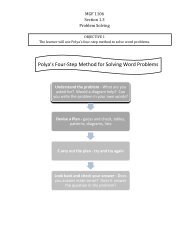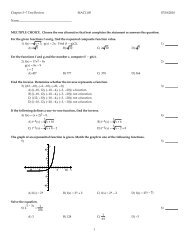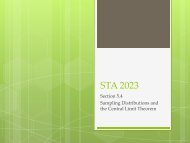MGF 1107 Section 15.2 Euler Paths and Euler Circuits Puzzle books ...
MGF 1107 Section 15.2 Euler Paths and Euler Circuits Puzzle books ...
MGF 1107 Section 15.2 Euler Paths and Euler Circuits Puzzle books ...
Create successful ePaper yourself
Turn your PDF publications into a flip-book with our unique Google optimized e-Paper software.
<strong>MGF</strong> <strong>1107</strong><br />
<strong>Section</strong> <strong>15.2</strong> <strong>Euler</strong> <strong>Paths</strong> <strong>and</strong> <strong>Euler</strong> <strong>Circuits</strong><br />
<strong>Puzzle</strong> <strong>books</strong> often have a problem that reads “Can you trace this figure without picking up your pencil<br />
<strong>and</strong> without going over any line twice?” Here are two examples.<br />
We can answer this question by using graph theory.<br />
Objective 1: The learner will determine if a path is an <strong>Euler</strong> path, an <strong>Euler</strong> circuit, or neither.<br />
<strong>Euler</strong> Path – a path that travels through every edge of a graph once <strong>and</strong> only once. Each graph<br />
must be traveled <strong>and</strong> no edge can be retraced.<br />
<strong>Euler</strong> Circuit – a circuit that travels through every edge of a graph once <strong>and</strong> only once<br />
Notes: Every <strong>Euler</strong> circuit is an <strong>Euler</strong> path because an <strong>Euler</strong> circuit is just an <strong>Euler</strong> path<br />
that begins <strong>and</strong> ends at the same vertex.<br />
Every <strong>Euler</strong> path is not a <strong>Euler</strong> circuit because an <strong>Euler</strong> path does not have to end at the<br />
same vertex it started at.<br />
Example 1: Work problems 1 – 3 on page 837.
Objective 2: The learner will use <strong>Euler</strong>’s Theorem.<br />
<strong>Euler</strong>’s Theorem:<br />
Number of Odd Vertices in a Connected Graph<br />
(Must be an even number)<br />
Exactly two<br />
•At least one<br />
<strong>Euler</strong> path but<br />
no <strong>Euler</strong> circuit<br />
•Each <strong>Euler</strong> path<br />
must start at<br />
one of the odd<br />
vertices <strong>and</strong><br />
end at the<br />
other one<br />
Zero<br />
•At least one<br />
<strong>Euler</strong> circuit<br />
(which is also<br />
an <strong>Euler</strong> path)<br />
•It can start <strong>and</strong><br />
end at any<br />
vertex.<br />
More than two<br />
•No <strong>Euler</strong> paths<br />
<strong>and</strong> No <strong>Euler</strong><br />
circuits<br />
Example 2: Given the number of odd <strong>and</strong> even vertices, determine if the graph has an <strong>Euler</strong> path<br />
(but no <strong>Euler</strong> circuits), an <strong>Euler</strong> circuit, or neither.<br />
a) The graph has 24 even vertices <strong>and</strong> no odd vertices.<br />
b) The graph has 84 even vertices <strong>and</strong> two odd vertices.<br />
c) The graph has 55 even vertices <strong>and</strong> six odd vertices.<br />
Example 3: Explain why the graph in problem 7 on page 837 has at least one <strong>Euler</strong> path. Use trial<br />
<strong>and</strong> error to find one such path.<br />
Solution: A (3) – odd, B (3) – odd, C (2) – even, D (4) – even, E (2) even.<br />
The graph has exactly two odd vertices so it has at least one <strong>Euler</strong> path.<br />
One path : A, C, D, A, B, D, E, B
Example 4: Explain why the graph in problem 10 on page 837 has an <strong>Euler</strong> circuit. Find one<br />
possible circuit.<br />
A<br />
B<br />
C<br />
D<br />
E<br />
Solution: A (4) – even, B (2) – even, C (4) – even, D(4) – even, E(2) – even<br />
The graph has no odd vertices so it has at least one <strong>Euler</strong> circuit.<br />
One circuit: A, B, C, E, D, C, A, D, A<br />
Example 5: Work problem 12 on page 837.<br />
Solution: A (2) – even, B(3) – odd, C(3) – odd, D(2) – even, E(3) – odd<br />
We’ve found more than two odd vertices so the graph has no <strong>Euler</strong> paths <strong>and</strong> no <strong>Euler</strong> circuits.
Let’s return to the opening example.<br />
<strong>Puzzle</strong> <strong>books</strong> often have a problem that reads “Can you trace this figure without picking up your pencil<br />
<strong>and</strong> without going over any line twice?” Here are two examples.<br />
Can we answer the question using graph theory?<br />
Objective 3: The learner will solve problems using <strong>Euler</strong>’s Theorem.<br />
Example 6: Work problems 48, 55 <strong>and</strong> 56 on pages 839 – 841.


